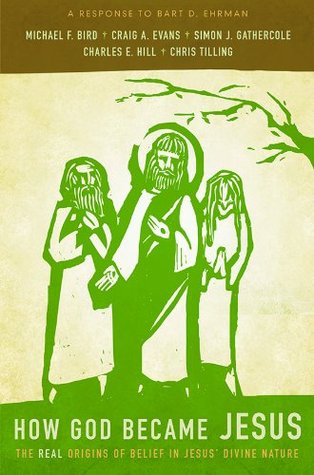Bird, Michael F., ed. How God Became Jesus: The Real Origins of Belief in Jesus’ Divine Nature. Grand Rapids: Zondervan, 2014. $16.99. 236 pages.
Michael Bird is joined by Craig A. Evans, Simon J. Gathercole, Charles E. Hill, and Chris Tilling to offer a rebuttal to Bart Ehrman’s work titled How Jesus Became God: The Exaltation of a Jewish Preacher from Galilee. Ehrman, professor in NT studies at UNC-Chapel Hill and self-professed atheist leaning agnostic, argues that the early church did not accept an incarnational view of Jesus, but rather an exalted view of Jesus, much like an angel. In other words, Ehrman does not hold that the early church believed Jesus to be divine in nature, but rather a human being elevated to an angelic or god-like status. Ehrman also thinks that the church came to accept a divine view of Jesus over a messy course of events. Bird and his colleagues combat Ehrman’s thesis in the book How Jesus Became God.
Bird and company successfully and systematically decimate Ehrman’s thesis in in their book How God Became Jesus: The Real Origins of Belief in Jesus’ Divine Nature while acknowledging that Ehrman does bring some interesting points to the discussion. After an introduction to the issues in chapter 1, Bird illustrates the error that Ehrman makes as he attempts to paste Greco-Roman and Jewish mystic thoughts upon the early church. In chapter 2, Bird successfully proves that early Christianity is rooted in Jewish monotheism.
In chapter 3, Bird offers evidence that Jesus viewed himself as divine, demeriting Ehrman’s claim that Jesus’ divinity was imposed upon him by later followers. Bird uses the synoptic Gospels (particularly that agreed to have come from theoretical Q–believed to have been the earliest material in the Gospels) along with Johannine testimony to prove that Jesus accepted a divine title, even with the title “Son of Man.”
In chapter 4, the best chapter of the book and the most destructive of all to Ehrman’s thesis, Craig Evans spoils Ehrman’s view that Jesus was never buried. Ehrman holds that the Romans would never have allowed Jews to bury their dead after crucifixion. Evans offers outstanding and overwhelming evidence to prove that the Romans not only allowed burials after crucifixions, but that it was common for them to do so (especially around times of Jewish festivals) even to the families of the deceased. Evans shows that this was common practice up until the time of Emperor Caligula in AD 37 (4-7 years after Jesus’ crucifixion). Chapter 4 is worth the price of the book alone!
In chapter 5, Simon Gathercole demonstrates the error in Ehrman’s thesis by showing that Jesus’ exaltation refers to his intensification of authority rather than his being. Gathercole uses the Synoptic Gospels to illustrate this point.
In chapters 6 and 7, Chris Tilling shows the errors in Ehrman’s category of development from exaltation to incarnation all christologies. Tilling challenges Ehrman’s usage of Galatians 4:14 as an interpretive key as well as a piecemeal usage of other early NT texts.
In chapter 8 and 9, Charles Hill examines the views of early church father’s and argues, successfully, that orthodoxy did not stem from a process over time, but rather stemmed from proper understandings of the Christian Scriptures. While admitting that some Christian doctrines are paradoxical, it doesn’t mean that they are in error. Hill also opposes Ehrman’s understanding of the Ebionites, Moralists, and Tertullian’s beliefs and practices. Bird affords a summary in chapter 10.
I highly recommend this book to anyone ho has been challenged by Ehrman’s writings. “How God Became Jesus” is an excellent read for Christians and skeptics alike. Parts of this book are more challenging to read than others, but it is worth the time to invest. Due to the overwhelming nature of their rebuttal to Ehrman’s work, I give this book 5 stars!

Copyright, March 16, 2016. Brian Chilton.





Reblogged this on Talmidimblogging.
Reblogged this on Talmidimblogging.